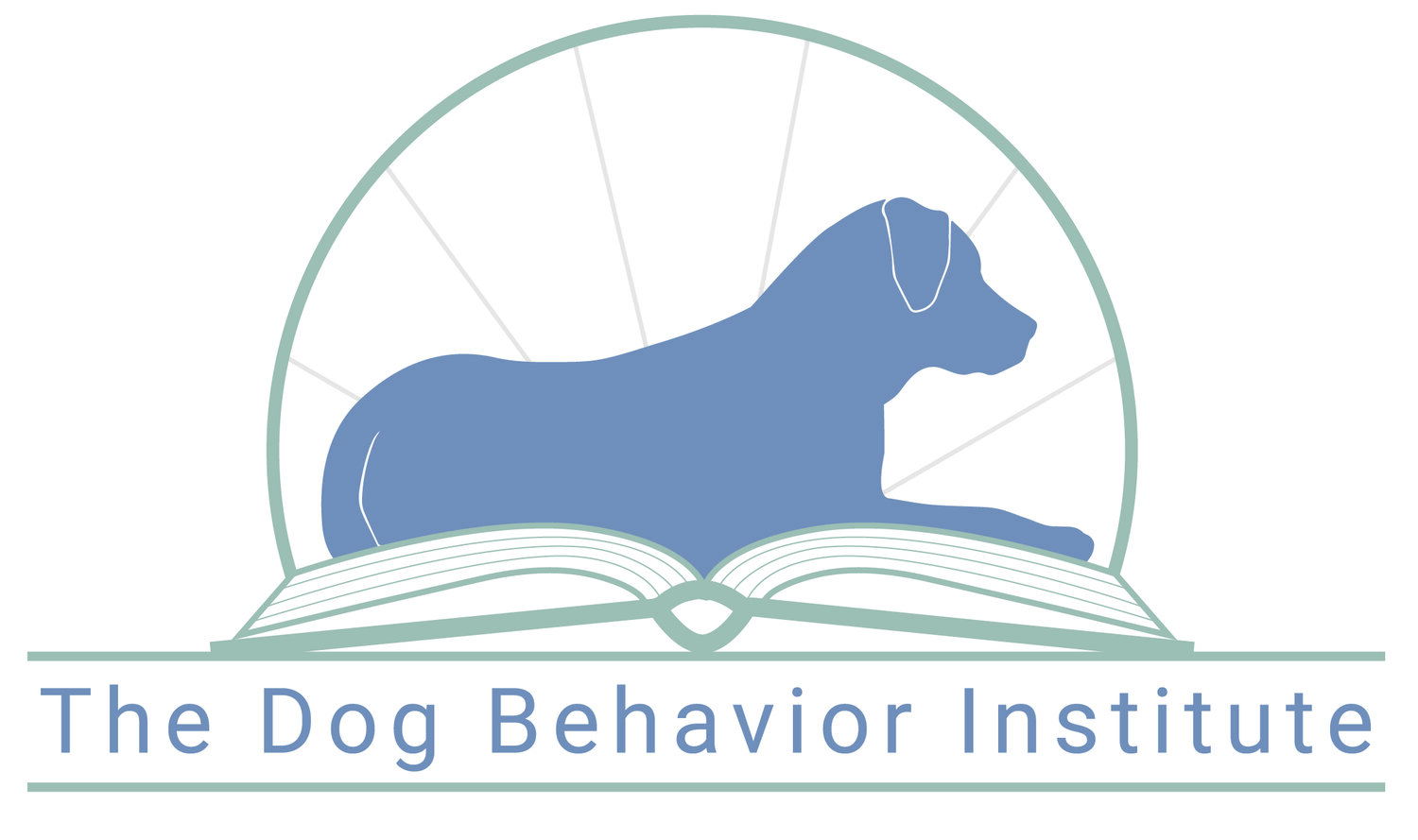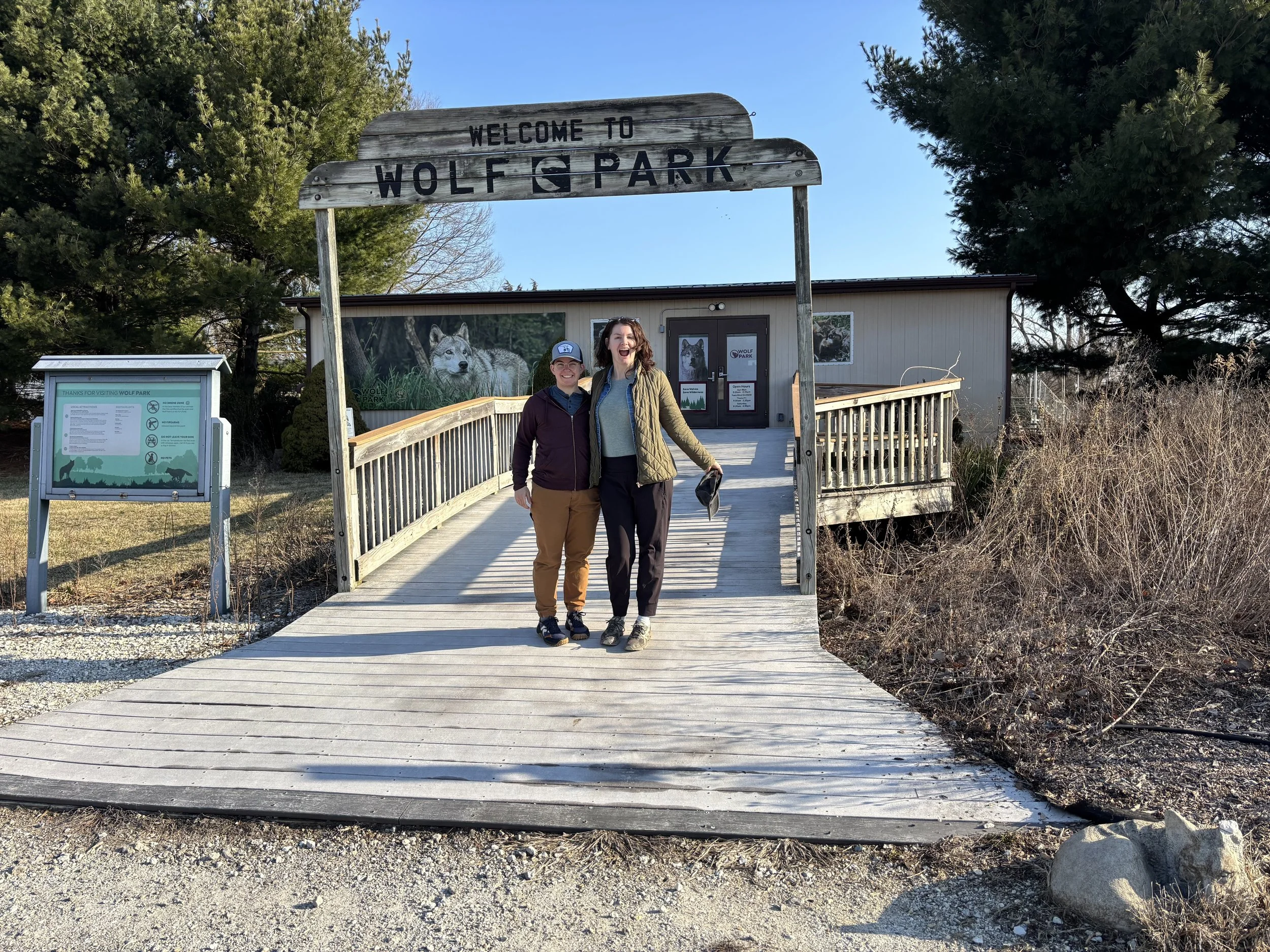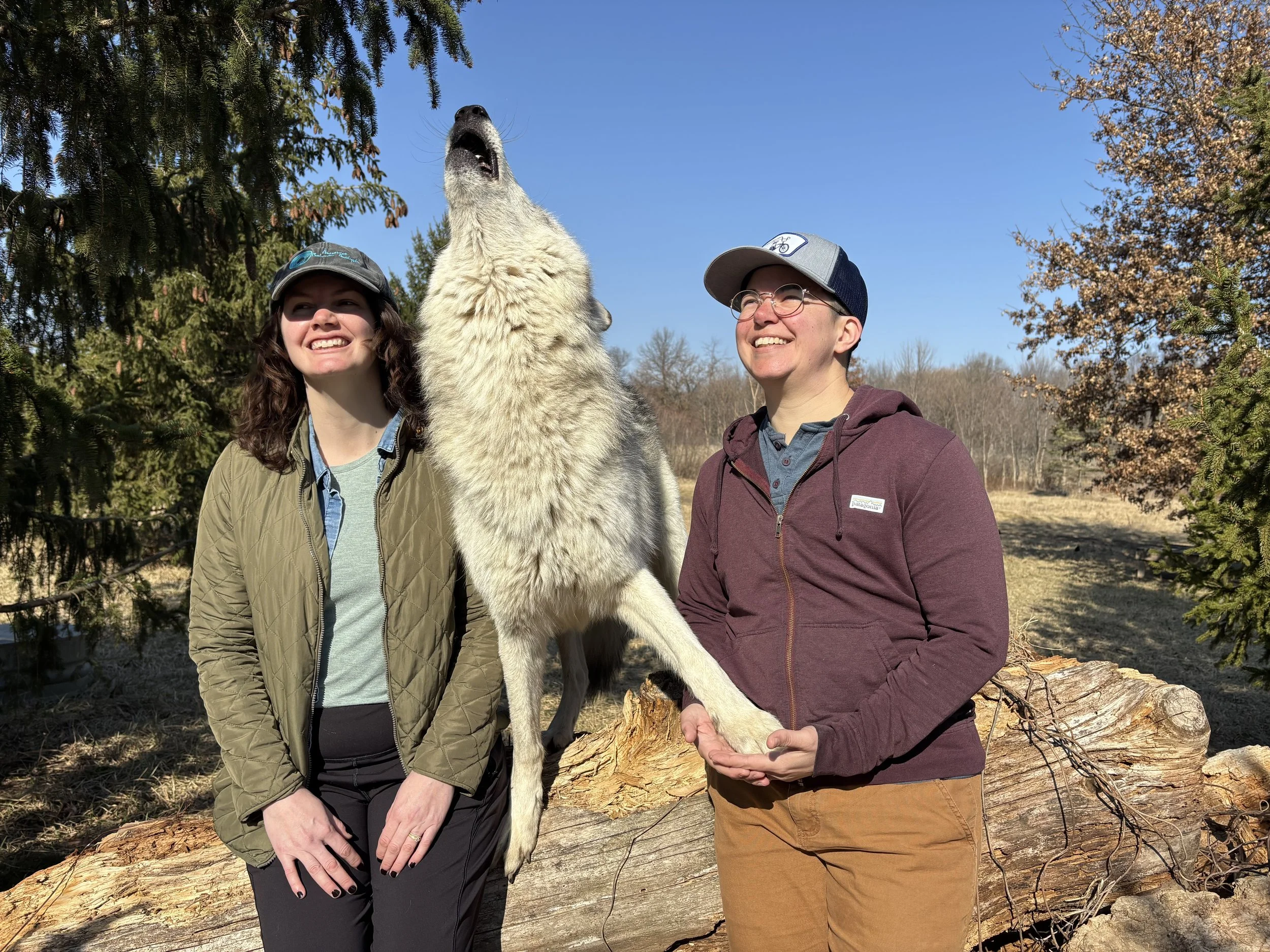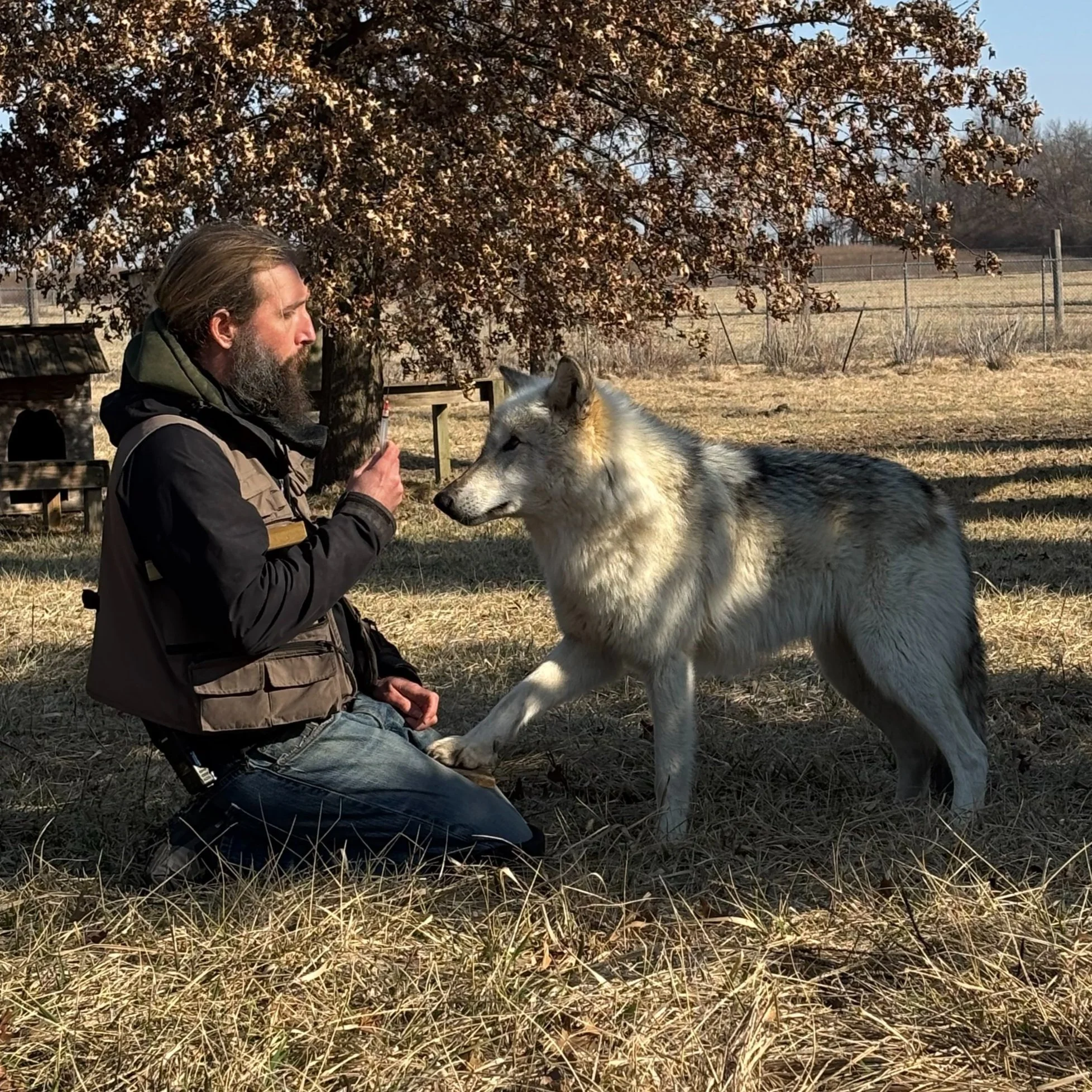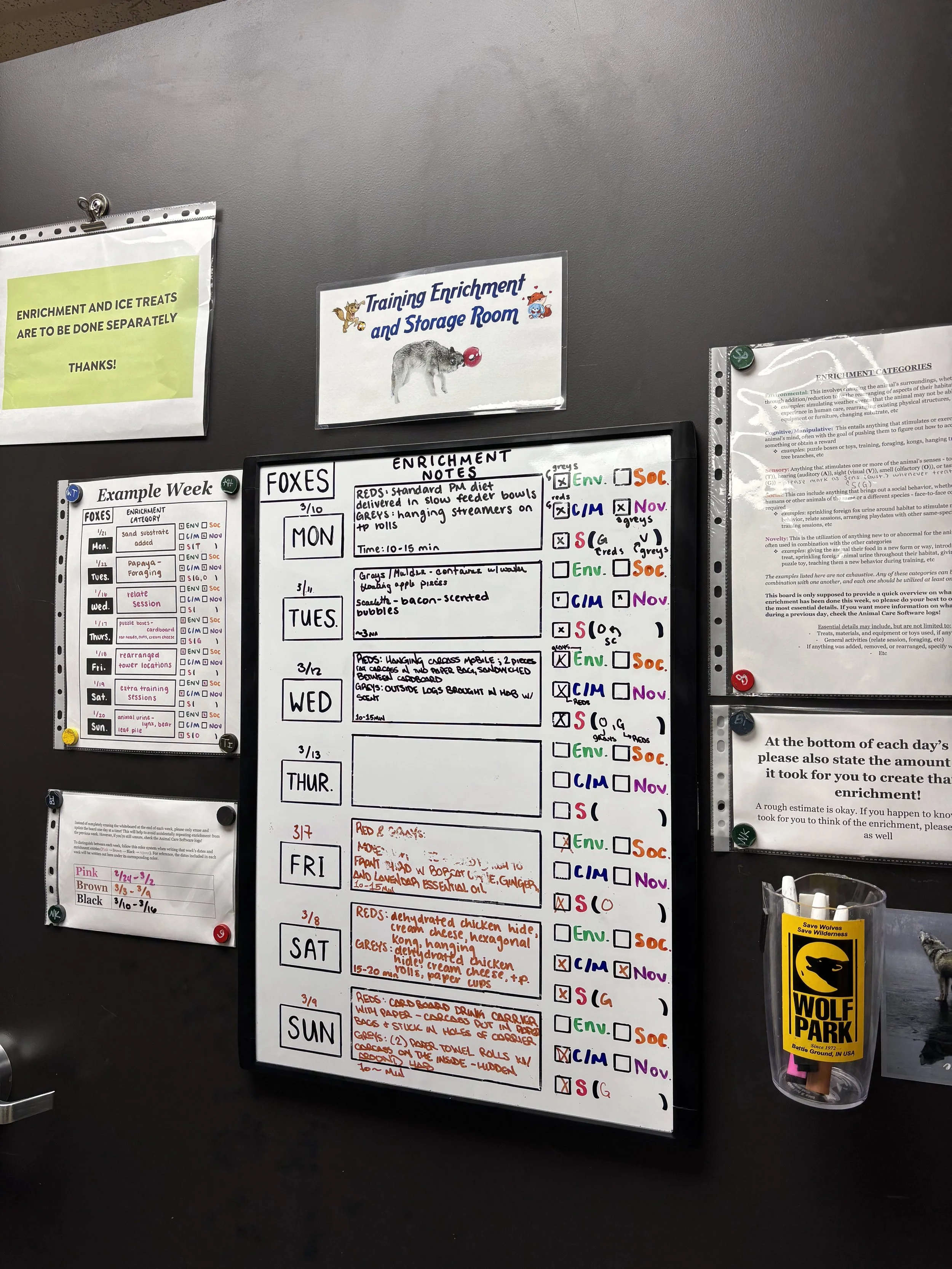Dreams Do Come True: A Day Trip to Wolf Park
By: Stephanie Keesey-Phelan
I’m sure it will come as no surprise that Ran and I (Stephanie) are animal lovers. Of course we love dogs, but we are also fond of basically all the animals out there, including one of our dogs’ closest relatives: the wolf. So you can imagine our excitement when we met Ryan Talbot at a behavior analysis conference last year. Ryan is the Behavioral Enrichment and Training Manager at Wolf Park: a leading center for research, conservation, and education of wolves and other canid species in Battleground, Indiana. Ran and I were familiar with Wolf Park, as the animals there frequently participate in published research, and we were delighted to learn more about the work that Ryan and his colleagues do. Ryan kindly extended an invitation for us to come visit.
ClickerExpo 2025, held in Rosemont, IL, provided the perfect excuse for a visit. We arranged to travel directly to Indiana with our friend and colleague Maia Huff-Owen the day before ClickerExpo started. We would spend the day touring Wolf Park and observing some training sessions, provide a talk for the staff on behavior analysis, and then head up to Rosemont for the conference.
Welcome to Wolf Park
Prior to our visit we watched a mandatory safety video and completed our waivers. During the 20 minute drive from the hotel to the sanctuary, I felt like a kid on Christmas morning - my excitement increasing as we got closer to Wolf Park and started seeing signs pointing the way. I reflected on how cool it would be to learn more about wolf behavior in general and to observe the ways in which cooperative care training and behavior analysis were at work in the husbandry care provided to the sanctuary animals.
We arrived at Wolf Park on Thursday March 13th in the morning and lucked out! March is a tricky month for weather but we had a beautiful, blue sky day. The staff and volunteers met us with a warm welcome and we perused the gift shop while we waited for Ryan to meet us and bring us to meet our first wolf of the day: Sparrow.
Sparrow
Stephanie & Ran with Sparrow
Sparrow is one of the eight resident Gray Wolves who call Wolf Park home and is, as we came to learn, a star pupil. Sparrow is eight years old and was born at Wolf Park on April 8, 2017. She was described to us as eager to learn and known for her love of training.
We were led into her enclosure where a few other folks had gathered and were sitting on the ground. Sparrow sauntered over for a brief investigation during which we tried to remember to breathe and follow our safety training.
Sparrow’s training sessions were a delight to observe. We saw her have blood drawn without any kind of restraint (chemical or mechanical). The team also demonstrated nail trims, teeth checks, and ear checks. Separately, Sparrow put her snout into a muzzle and wore it comfortably for a considerable period of time during training.
For each husbandry task, Sparrow had a way to “opt in” or start the procedure. In the case of the blood draw, you can see in the photo below she placed her paw on a wooden target which cued Ryan to start the procedure.
Watching Sparrow train with Ryan and other Wolf Park staff was an inspiration and an important reminder of what we can accomplish when we focus on positive reinforcement, cooperative care, and assent.
Enrichment
Another area of emphasis during our visit was enrichment. Wolf Park interns, staff, and volunteers work hard to create enrichment plans for each species in general and each individual specifically. During our visit, we were fortunate to observe a neat enrichment activity provided to Mulder and Scarlet, the sanctuary’s two Red Foxes. They had created a bundle of sticks inserted into toilet paper tubes with feathers stuck to the outsides. These little creations were hung from branches in the animals’ enclosures and were designed to mimic potential prey for red foxes.
I wish we had captured some photos of the interaction. Having not observed Red Foxes before it was fascinating to see how their behavior differed from that of the wolves and how quickly and readily they interacted with the enrichment items.
Our Presentation
We capped off our day at Wolf Park by providing a presentation on behavior analysis with a specific emphasis on defining behavior and data collection and analysis. Ran, Maia, and I worked together to create an interactive presentation tailored to the types of behaviors that come up for the sanctuary’s resident human and non-human animals. Of course we’re all interested in wolf behavior, but equally important is the behavior of the staff, interns, volunteers, and visitors of the sanctuary.
One of the things I found most interesting about presenting a workshop on this topic was addressing and integrating ethology. Ethology is the study of animal behavior and it has some key differences in its approach when compared to behavior analysis. In particular, ethology often (but not always) focuses on behaviors typical and/or specific to a species of animal. An ethogram describes all the behaviors that are observed in a particular species. Where behavior analysis differs is in looking at the behavior of a specific individual and the contingencies related to that individual including their genetics, individual history, and current context. These approaches can absolutely be complementary and this was one of the first opportunities we’ve had to really explore with a group how ethology and behavior analysis can be weaved together.
Takeaways
Our day at Wolf Park was such a treat. Our big takeaways included:
It is an inspiration to see talented people work with wild animals, for whom there are often significant barriers and safety risks. It is a reminder of what good, thoughtful training and communication can accomplish between species.
Wolves are so cool, just as cool as we always thought they were. AND, we were also wowed by the bison and foxes we observed. We hope we’ll have an opportunity to return to Wolf Park to learn more about these fascinating animals.
Even as we see procedures that are often used with domestic animals applied to work with wild animals (i.e., start button behaviors), we are reminded that dogs are not wolves. Many of the things we used to think we know about wolves, like pack theory, have been thoroughly debunked (see this great post by Eileen Anderson on The False Hypothesis of the Pack Theory which has some excellent links to other resources on wolf behavior). Science is always evolving and growing, and to that end, it is critical that we both know the species we are working with (including their ethogram!) and that we look at each individual specifically, considering their specific needs, history, and context.
